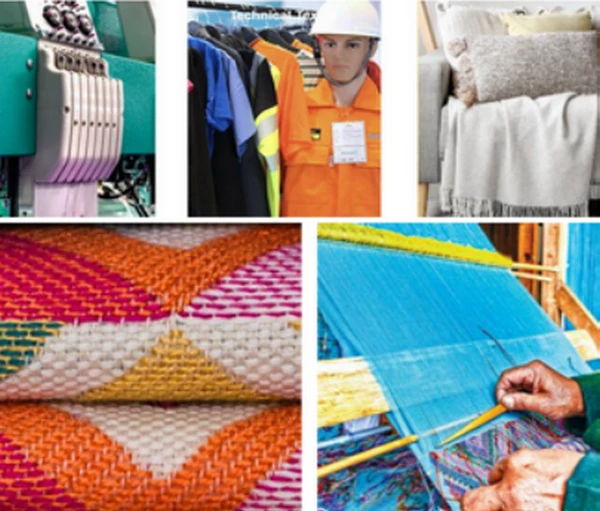 List Of Exhibitors at Bharat Tex 2025 given at the end
List Of Exhibitors at Bharat Tex 2025 given at the end
Bharat Tex 2025: Revolutionizing Fashion, Sustainability, and Innovation
The Bharat Tex 2025, India’s largest global textile exhibition,, held at Bharat Mandapam in New Delhi, wasn’t just another trade show – it represented a pivotal moment in India’s journey toward global textile leadership, bringing together over 5,000 exhibitors and 120,000 visitors from across the world in an unprecedented display of innovation, sustainability, and traditional craftsmanship.
The sheer magnitude of Bharat Tex 2025 reflects India’s growing prominence in the global textile landscape. Spanning 2.2 million square feet, this event showcased our country’s complete textile ecosystem. India has already achieved textile exports worth ?3 lakh crore, and we’re now positioned to triple this figure to ?9 lakh crore by 2030. As the sixth-largest textile exporter globally, contributing 8.21% to our country’s total exports and holding a 4.5% share in global trade, we’re not just participating in the global market – we’re actively shaping it. The United States and European Union account for 47% of our textile and apparel exports, demonstrating our strong international partnerships. The sector provides direct employment to 45 million people and indirectly supports over 100 million livelihoods, making it a cornerstone of our economic development and a powerful driver of rural employment and women’s empowerment.
Innovation and Policy Framework
The government’s visionary approach has created a robust foundation for growth through multiple groundbreaking initiatives. The PM MITRA Parks Scheme is establishing seven mega textile parks with an expected investment of USD 10 billion, offering world-class infrastructure and plug-and-play facilities. The Production Linked Incentive Scheme, with approved incentives of Rs.10,683 crore, is revolutionizing the production of MMF Apparel and Technical Textiles. We’re also investing heavily in technical education and skill development through the Samarth scheme, which provides demand-driven, placement-oriented training across the textile value chain. The integration of intelligent manufacturing, featuring AI, IoT, and advanced analytics, is transforming traditional production processes. Recently, we’ve approved four innovative start-ups under the GREAT scheme, each receiving ?50 lakhs for breakthrough developments in Medical, Industrial, and Protective Textiles. Additionally, prestigious institutions like IIT Indore and NIT Patna have received ?6.5 crores to introduce specialized courses in emerging textile technologies.
Cultural Heritage and Modern Evolution

What truly sets India apart is our unique ability to blend centuries-old craftsmanship with modern innovation. The ‘Indie Haat’ showcase brought together 85 talented artisans and weavers, presenting over 80 different types of handcrafted and handwoven products that exemplify our rich cultural heritage. The ‘Breathing Threads’ fashion show demonstrated how our traditional handloom and handicraft sectors are evolving to meet contemporary demands while preserving their cultural significance. From the intricate Banarasi silks of Varanasi to the luxurious Kanjeevaram silks of Tamil Nadu, and from the delicate Jamdani of West Bengal to cutting-edge technical textiles, we’re creating a harmonious fusion of heritage and innovation. Our home textile sector showcases this diversity beautifully, with regions like Gujarat known for vibrant embroidery and Kashmir famous for its luxurious woollen shawls and rugs. This combination of traditional craftsmanship and modern techniques has positioned India as a unique player in the global textile market, offering products that tell stories of our heritage while meeting contemporary market demands.
As we look to the future, Bharat Tex 2025 stands as a testament to India’s commitment to leading the global textile revolution. We’re not just preserving our rich textile heritage; we’re actively redefining excellence through research-driven advancements and sustainable practices. The success of this event has laid a strong foundation for India’s emergence as a textile powerhouse, one that combines the wisdom of traditional craftsmanship with the possibilities of modern innovation. Together, we’re weaving a future where India’s textile industry doesn’t just participate in global markets – it leads them.
PM Addresses Bharat Tex 2025
The Prime Minister, Shri Narendra Modi, addressed Bharat Tex 2025 at Bharat Mandapam, New Delhi, today. He also toured the exhibition. Welcoming everyone to the event, he noted that Bharat Tex is becoming a significant global textile event. This year, the event saw participation from all twelve value chain communities, including accessories, garments, machinery, chemicals, and dyes.
He highlighted Bharat Tex as a strong platform for engagement, collaboration, and partnership among policymakers, CEOs, and industry leaders worldwide. He praised the organizers’ efforts and noted that over 120 countries participated this year, giving exhibitors immense exposure and the opportunity to expand their businesses globally.
Shri Modi shared that he visited many stalls and interacted with entrepreneurs, who reported gaining new buyers and expanding their businesses due to the event. He emphasized Bharat Tex’s role in boosting investments, exports, and overall growth in the textile sector. Shri Modi urged the banking sector to support entrepreneurs in the textile industry to create employment and opportunities.
Showcasing India’s cultural diversity, Shri Modi highlighted various traditional garments, such as Lucknowi chikankari, bandhani, patola, Banarasi silk, Kanjivaram silk, and pashmina. He stressed the importance of promoting the diversity and uniqueness of India’s textile industry.
Reflecting on his vision of farm, fiber, fabric, fashion, and foreign, Shri Modi noted that India saw a 7% increase in textile exports last year, making it the sixth-largest exporter globally. The textile industry’s growth is the result of consistent efforts and policies over the past decade, with foreign investment doubling in this sector.
Shri Modi mentioned the Mission for Cotton Productivity, which aims to ensure a reliable cotton supply and make Indian cotton globally competitive. He also highlighted the focus on technical textiles, indigenous carbon fiber, and skilling initiatives for the textile workforce.
To promote handloom craftsmanship, Shri Modi discussed efforts to enhance skills and opportunities for artisans, ensuring their products reach global markets. He mentioned the India-hand-made e-commerce platform, which has seen thousands of handloom brands register.
The Prime Minister noted the success of the Textiles Startup Grand Challenge and encouraged youth to bring forward new techno-textile startups. He emphasized the growing role of technology and AI in discovering new trends and creating styles.
Shri Modi also addressed environmental concerns, highlighting the need to maximize resource utilization and minimize waste in the textile industry. He pointed out India’s traditional skills in textile recycling and up-cycling as potential global market opportunities.
He concluded by expressing confidence that Bharat Tex would continue to set new records of success each year. Union Minister for Textiles, Shri Giriraj Singh, and Minister of State for Textiles, Shri Pabitra Margherita, were also present at the event.





